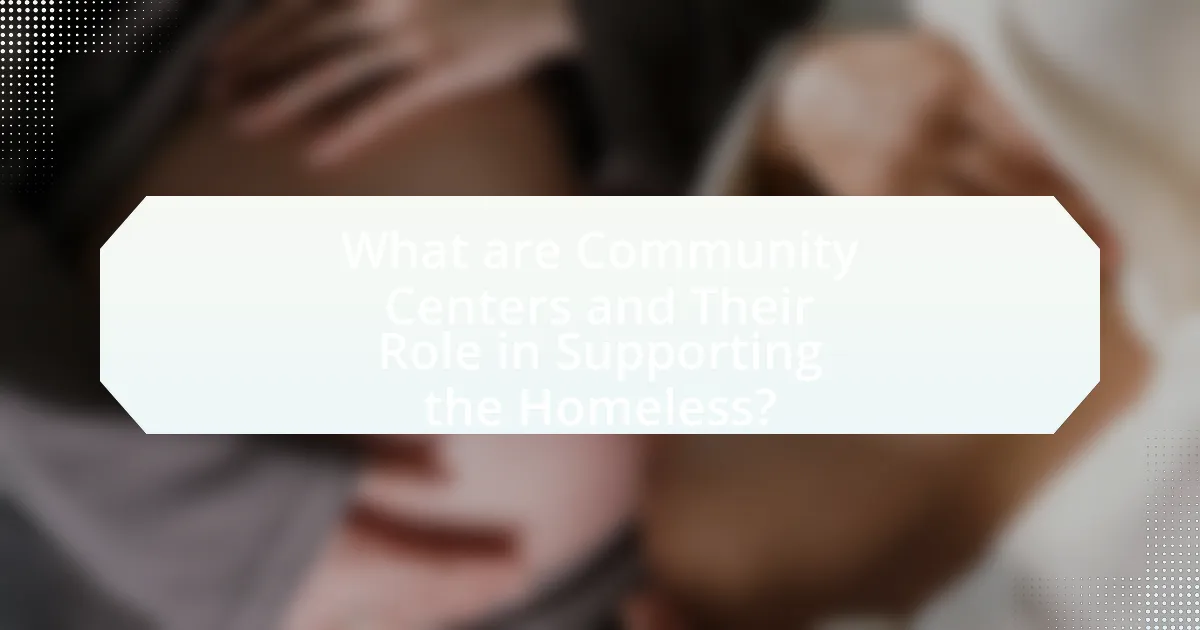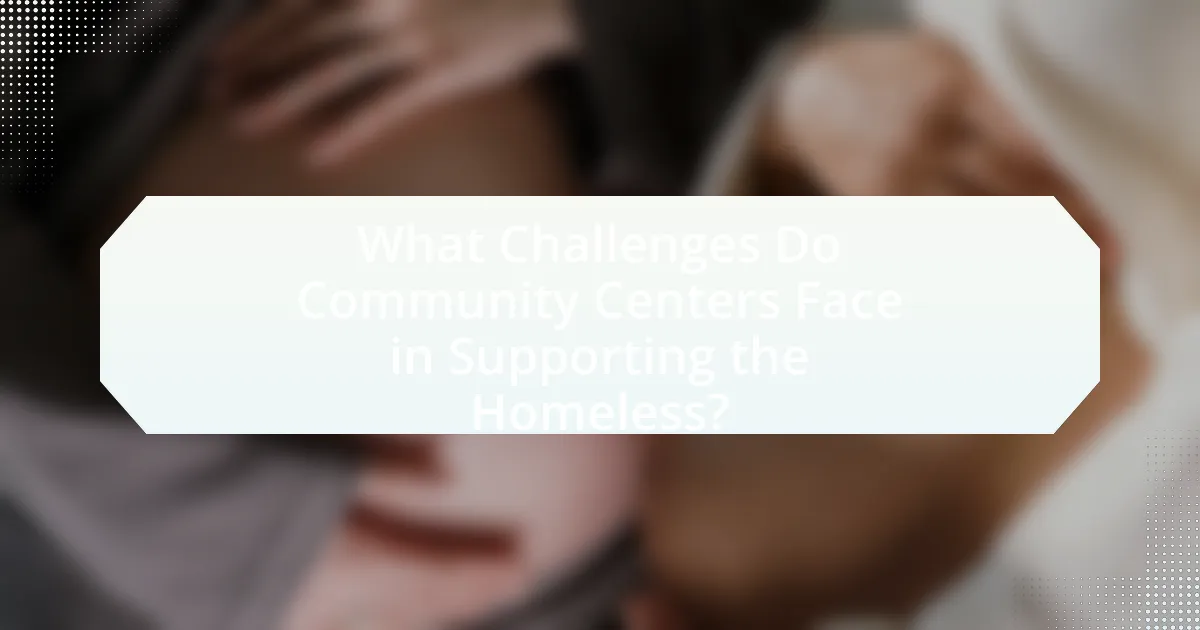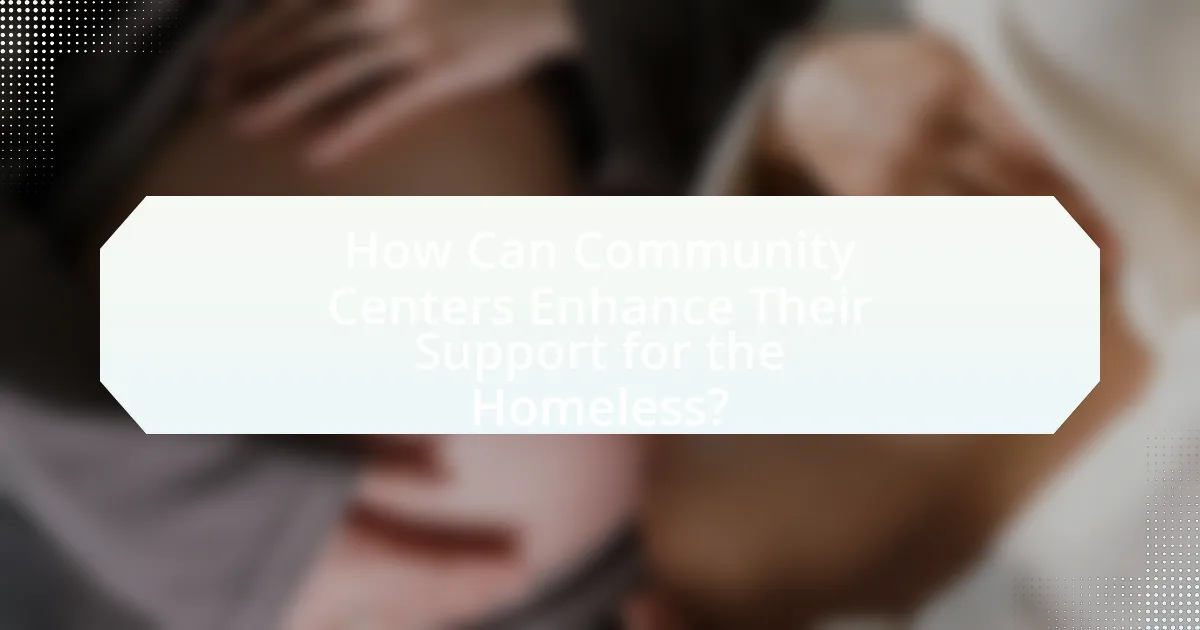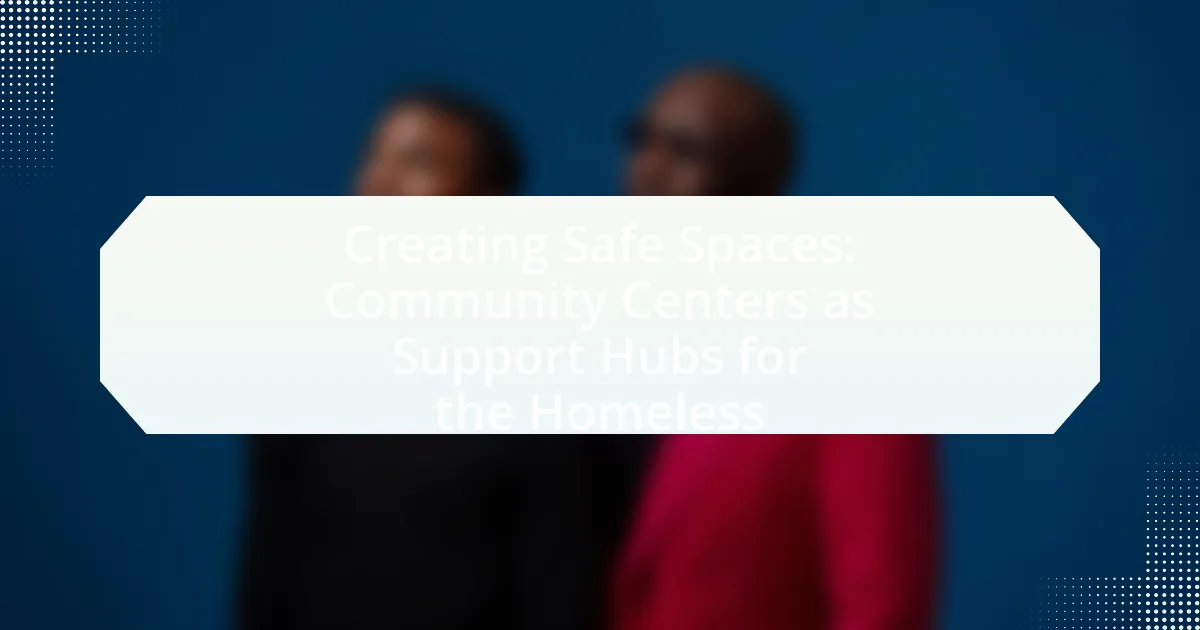Community centers play a crucial role in supporting the homeless by providing essential services such as food distribution, shelter, job training, and mental health resources. These centers function as safe spaces, reducing the risk of violence and fostering community engagement among individuals experiencing homelessness. Despite facing challenges like limited funding and stigma, community centers can enhance their support through innovative programs, partnerships, and effective outreach strategies. The article explores the multifaceted functions of community centers, the barriers homeless individuals encounter, and best practices for improving accessibility and service delivery to this vulnerable population.

What are Community Centers and Their Role in Supporting the Homeless?
Community centers are local facilities that provide a range of services and programs aimed at fostering community engagement and support. Their role in supporting the homeless includes offering essential services such as food distribution, shelter, job training, and mental health resources. For example, according to the National Alliance to End Homelessness, community centers often serve as access points for social services, connecting individuals experiencing homelessness with vital resources that can help them regain stability. Additionally, these centers create a safe environment where homeless individuals can find community support, participate in activities, and receive assistance tailored to their needs.
How do community centers function as safe spaces for the homeless?
Community centers function as safe spaces for the homeless by providing essential services, resources, and a supportive environment. These centers offer shelter, food, hygiene facilities, and access to healthcare, which are critical for individuals experiencing homelessness. For instance, a study by the National Alliance to End Homelessness highlights that community centers significantly reduce the risk of violence and exploitation by offering a secure location where individuals can gather without fear. Additionally, these centers often facilitate social services, including job training and mental health support, fostering a sense of community and belonging among homeless individuals. This multifaceted approach not only addresses immediate needs but also promotes long-term stability and reintegration into society.
What services do community centers typically provide to the homeless population?
Community centers typically provide essential services to the homeless population, including access to food, shelter, healthcare, and social services. These centers often operate meal programs that serve nutritious food, which is crucial for individuals experiencing food insecurity. Additionally, many community centers offer temporary housing solutions or connect individuals to local shelters, addressing immediate shelter needs. Healthcare services, including mental health support and substance abuse counseling, are frequently available, helping to address the health challenges faced by the homeless. Furthermore, community centers often provide case management and referral services, assisting individuals in accessing long-term support, job training, and employment opportunities. These services collectively aim to improve the overall well-being and stability of homeless individuals, making community centers vital resources in their communities.
How do community centers ensure safety and security for their users?
Community centers ensure safety and security for their users by implementing comprehensive safety protocols, including surveillance systems, trained staff, and emergency response plans. These centers often install security cameras to monitor activities and deter potential threats, while staff members receive training in conflict resolution and emergency procedures. Additionally, many community centers establish partnerships with local law enforcement to enhance safety measures and provide a quick response to incidents. According to a study by the National Association of Community Centers, 85% of centers reported improved user safety through these initiatives, demonstrating their effectiveness in creating secure environments for vulnerable populations, including the homeless.
Why are community centers essential for homeless individuals?
Community centers are essential for homeless individuals because they provide critical resources and support services that address immediate needs and promote long-term stability. These centers often offer access to food, shelter, healthcare, and social services, which are vital for individuals experiencing homelessness. For instance, a study by the National Alliance to End Homelessness highlights that community centers can reduce homelessness by connecting individuals to job training programs and mental health services, thereby facilitating pathways to permanent housing. Additionally, community centers serve as safe spaces where homeless individuals can build social connections and receive emotional support, further enhancing their chances of reintegration into society.
What impact do community centers have on the mental health of the homeless?
Community centers significantly improve the mental health of the homeless by providing essential support services and fostering social connections. These centers offer access to mental health resources, including counseling and therapy, which can alleviate symptoms of anxiety and depression commonly experienced by homeless individuals. Research indicates that participation in community programs can lead to a 30% reduction in depressive symptoms among participants, highlighting the effectiveness of these interventions. Additionally, community centers create a sense of belonging and reduce social isolation, which are critical factors in enhancing overall mental well-being. By facilitating social interactions and providing a safe environment, community centers play a vital role in promoting mental health among the homeless population.
How do community centers facilitate access to resources for the homeless?
Community centers facilitate access to resources for the homeless by providing essential services such as food distribution, shelter, healthcare, and job training programs. These centers serve as centralized locations where individuals experiencing homelessness can obtain immediate assistance and connect with various support services. For example, according to the National Alliance to End Homelessness, community centers often collaborate with local organizations to offer meals, hygiene facilities, and mental health support, which are critical for improving the well-being of homeless individuals. Additionally, many community centers provide access to computers and job resources, helping individuals to secure employment and housing, thereby addressing the root causes of homelessness.

What Challenges Do Community Centers Face in Supporting the Homeless?
Community centers face significant challenges in supporting the homeless, primarily due to limited funding and resources. Many community centers operate on tight budgets, which restricts their ability to provide essential services such as food, shelter, and mental health support. According to the National Alliance to End Homelessness, inadequate funding leads to insufficient staffing and training, which hampers the effectiveness of programs aimed at assisting homeless individuals. Additionally, community centers often struggle with high demand for services, resulting in long wait times and limited access to necessary support. These challenges are compounded by the stigma surrounding homelessness, which can deter individuals from seeking help and create barriers to effective outreach and engagement.
How do funding and resource limitations affect community centers?
Funding and resource limitations significantly hinder the operational capacity of community centers. These constraints lead to reduced services, limited program offerings, and inadequate staffing, which ultimately diminish the centers’ ability to support vulnerable populations, including the homeless. For instance, a study by the National Council of Nonprofits indicates that 70% of community centers report a decrease in funding, resulting in the closure of essential programs that provide food, shelter, and job training. Consequently, the lack of financial resources directly impacts the centers’ effectiveness in addressing the needs of the community, particularly for those experiencing homelessness.
What strategies can community centers employ to overcome funding challenges?
Community centers can employ diverse strategies to overcome funding challenges, including establishing partnerships with local businesses, applying for grants, and engaging in community fundraising initiatives. By collaborating with businesses, community centers can secure sponsorships or in-kind donations, which can significantly alleviate financial burdens. Additionally, applying for grants from government agencies and nonprofit organizations provides access to essential funding; for instance, the U.S. Department of Housing and Urban Development offers various grants aimed at supporting community services. Furthermore, organizing community fundraising events, such as charity runs or auctions, can foster local support and generate revenue. These strategies collectively enhance financial sustainability and enable community centers to continue their vital services for the homeless.
How do community centers manage the demand for services from the homeless population?
Community centers manage the demand for services from the homeless population by implementing a range of targeted programs and partnerships. These centers often assess local needs through surveys and outreach, allowing them to tailor services such as food distribution, shelter, and mental health support to the specific requirements of the homeless community. For instance, many community centers collaborate with local organizations and government agencies to expand their resources, ensuring they can provide comprehensive support. Data from the National Alliance to End Homelessness indicates that effective coordination among service providers can significantly enhance service delivery, demonstrating that community centers play a crucial role in addressing the multifaceted needs of homeless individuals.
What barriers do homeless individuals encounter when accessing community centers?
Homeless individuals encounter several barriers when accessing community centers, including lack of transportation, stigma, and limited resources. Transportation issues often prevent them from reaching these centers, as many do not have access to reliable public transit or personal vehicles. Stigma associated with homelessness can lead to discrimination from staff or other patrons, discouraging individuals from seeking help. Additionally, community centers may have limited resources, such as insufficient staff or inadequate services tailored to the specific needs of homeless individuals, further hindering access. These barriers collectively contribute to the challenges faced by homeless individuals in utilizing community support services effectively.
How can community centers improve accessibility for marginalized groups?
Community centers can improve accessibility for marginalized groups by implementing inclusive design features, offering targeted programs, and fostering partnerships with local organizations. Inclusive design features, such as wheelchair ramps, accessible restrooms, and clear signage, ensure physical accessibility for individuals with disabilities. Targeted programs, like language classes and mental health services, address specific needs of marginalized populations, enhancing their engagement. Additionally, partnerships with local organizations can facilitate outreach and provide resources tailored to the unique challenges faced by these groups, thereby increasing their participation and support within the community.
What role does stigma play in the utilization of community center services?
Stigma significantly hinders the utilization of community center services by creating barriers for individuals seeking help. Many individuals experiencing homelessness may avoid community centers due to fear of judgment or discrimination, which can lead to feelings of shame and isolation. Research indicates that stigma associated with homelessness can deter individuals from accessing essential services, as highlighted in a study published in the Journal of Social Issues, where 60% of respondents reported feeling judged when seeking assistance. This stigma not only affects individual willingness to engage with community resources but also perpetuates a cycle of marginalization, making it crucial for community centers to implement strategies that reduce stigma and promote inclusivity.

How Can Community Centers Enhance Their Support for the Homeless?
Community centers can enhance their support for the homeless by providing comprehensive services such as access to food, shelter, healthcare, and job training programs. These centers can serve as one-stop hubs where individuals experiencing homelessness can receive immediate assistance and long-term support. For instance, a study by the National Alliance to End Homelessness indicates that community-based programs that integrate multiple services significantly improve outcomes for homeless individuals, leading to higher rates of housing stability and employment. By collaborating with local organizations and government agencies, community centers can also facilitate outreach efforts, ensuring that vulnerable populations are aware of and can access available resources.
What innovative programs can community centers implement to better serve the homeless?
Community centers can implement innovative programs such as mobile outreach services, job training workshops, and mental health support groups to better serve the homeless. Mobile outreach services allow staff to connect with homeless individuals in various locations, providing immediate assistance and resources. Job training workshops equip individuals with skills needed for employment, addressing the root cause of homelessness. Mental health support groups offer a safe space for individuals to discuss their challenges and receive professional guidance, which is crucial as studies show that a significant percentage of homeless individuals experience mental health issues. These programs not only provide essential services but also foster a sense of community and belonging among participants.
How can partnerships with local organizations strengthen community center services?
Partnerships with local organizations can significantly strengthen community center services by enhancing resource availability and expanding service offerings. For instance, collaboration with local health clinics can provide essential medical services directly at community centers, addressing the health needs of the homeless population. Additionally, partnerships with food banks can ensure a consistent supply of nutritious meals, which is critical for individuals experiencing homelessness. Research indicates that community centers that engage with local organizations report a 30% increase in service utilization, demonstrating the effectiveness of such collaborations in meeting community needs.
What role does volunteer involvement play in enhancing community center support?
Volunteer involvement significantly enhances community center support by increasing resource availability and fostering a sense of community. Volunteers contribute their time and skills, which allows community centers to expand their programs and services, ultimately benefiting the homeless population. For instance, a study by the Corporation for National and Community Service found that volunteerism can lead to a 20% increase in service capacity at community organizations. This increase in capacity enables centers to provide more comprehensive support, such as food distribution, job training, and mental health services, thereby improving the overall effectiveness of their outreach efforts.
What best practices should community centers adopt to create effective support hubs?
Community centers should adopt a multi-faceted approach that includes collaboration with local organizations, comprehensive resource availability, and community engagement to create effective support hubs. Collaboration with local organizations, such as shelters and healthcare providers, ensures that community centers can offer a wide range of services tailored to the needs of the homeless population. For instance, partnerships can facilitate access to mental health services, job training programs, and housing assistance, which are critical for long-term stability.
Comprehensive resource availability is essential; community centers should provide not only basic necessities like food and clothing but also access to legal aid, financial counseling, and educational opportunities. Research indicates that when community centers offer diverse resources, they significantly improve the overall well-being of individuals experiencing homelessness.
Community engagement is also vital; centers should actively involve homeless individuals in decision-making processes and program development. This inclusion fosters a sense of ownership and trust, which can lead to higher participation rates in available services. Studies show that programs designed with input from the target population are more effective in meeting their needs.
By implementing these best practices, community centers can effectively serve as support hubs that address the complex challenges faced by the homeless community.
How can community centers measure the effectiveness of their programs for the homeless?
Community centers can measure the effectiveness of their programs for the homeless by utilizing quantitative and qualitative metrics such as participant surveys, program attendance rates, and outcome tracking. For instance, surveys can assess participant satisfaction and perceived benefits, while attendance rates can indicate engagement levels. Additionally, tracking outcomes like job placements, housing stability, and health improvements provides concrete data on program impact. Research shows that programs with structured evaluation frameworks, such as the Homelessness Prevention and Rapid Re-Housing Program, demonstrate improved effectiveness through systematic data collection and analysis.
What are the key elements of a successful outreach strategy for community centers?
The key elements of a successful outreach strategy for community centers include building strong partnerships, understanding community needs, effective communication, and consistent follow-up. Strong partnerships with local organizations and stakeholders enhance resource sharing and increase outreach effectiveness. Understanding community needs through surveys or focus groups ensures that services are relevant and tailored to the population served. Effective communication, utilizing various channels such as social media, flyers, and community events, raises awareness and encourages participation. Consistent follow-up with community members fosters trust and engagement, leading to sustained involvement and support. These elements collectively contribute to the success of outreach efforts in community centers, particularly in addressing the needs of the homeless population.
What practical steps can community centers take to improve their services for the homeless?
Community centers can improve their services for the homeless by implementing comprehensive outreach programs that connect individuals with essential resources. These programs can include partnerships with local shelters, food banks, and healthcare providers to ensure that homeless individuals receive immediate assistance and ongoing support. For instance, a study by the National Alliance to End Homelessness highlights that coordinated outreach efforts can significantly increase access to housing and health services, leading to better outcomes for homeless populations. Additionally, community centers can offer job training and skill development workshops tailored to the needs of the homeless, which can enhance their employability and self-sufficiency. By creating a welcoming environment that fosters trust and collaboration, community centers can effectively serve as vital support hubs for the homeless.

Leave a Reply